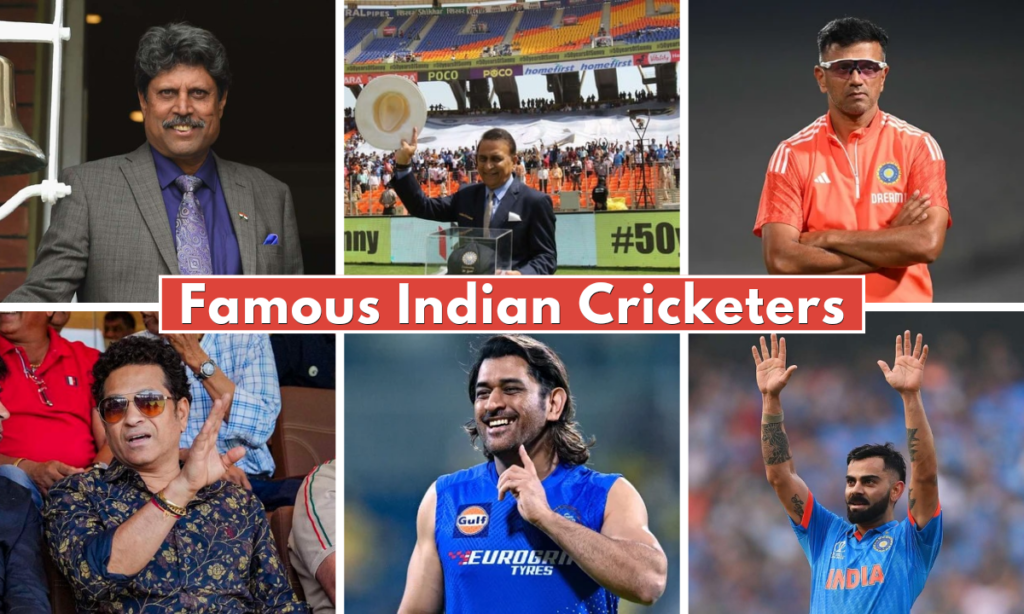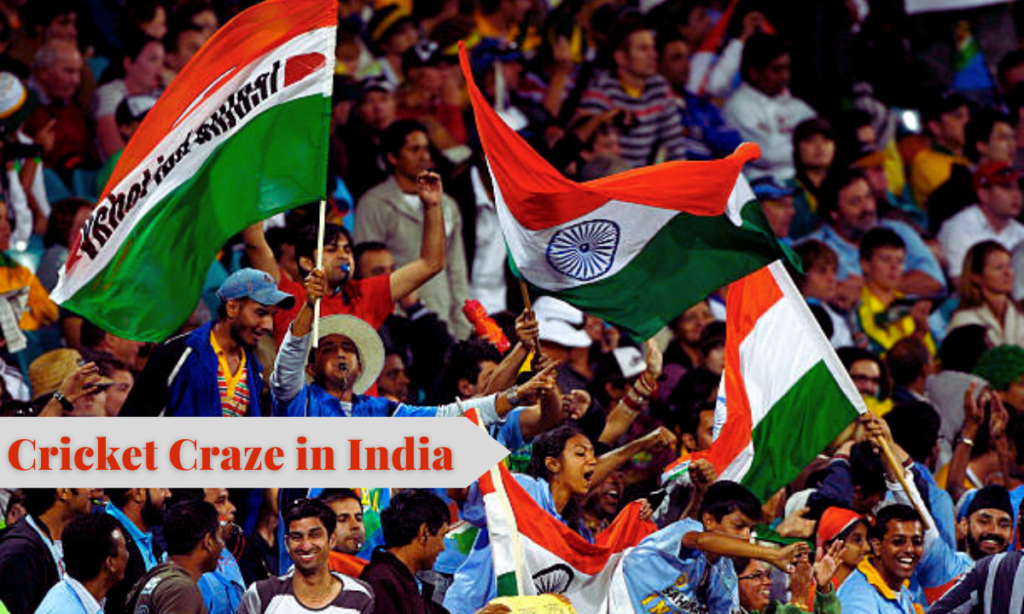Cricket in India is more than just a sport; it’s a cultural phenomenon. With a fan base that spans across all age groups and genders, cricket has become an integral part of the Indian identity. From gully cricket matches in small towns to packed stadiums during major tournaments, the passion for the game runs deep in the veins of every Indian cricket fan.
We delve into the cricket craze in India, exploring what makes it such a match made in sporting heaven. We’ll explore the history of cricket in India, the rise of iconic players who have become legends, and the impact cricket has had on the nation’s psyche.
We’ll also take a closer look at the IPL (Indian Premier League), the dynamic and star-studded franchise-based tournament that has revolutionized the cricketing landscape in the country. So join us on this cricketing journey as we uncover the secrets behind India’s undying love for the game. From nail-biting finishes to unforgettable moments, cricket in India is a saga that keeps the nation united and enthralled.
History of cricket in India
The history of cricket in India is a long and fascinating one, dating back to the 18th century. Here’s a quick timeline:
- Early Days (1700s-1800s): British sailors and merchants introduced cricket to India. The first cricket club, the Calcutta Cricket Club (CCC), was established in 1792, making it the second-oldest cricket club globally.
- Rise of Indian Participation (1800s-1900s): The Parsi community formed the Oriental Cricket Club in 1848, the first Indian community-based cricket club. Matches between Europeans and Indians became common, with some talented Indian players even playing for England.
- National Team and Test Status (1900s-1940s): An “All-India” team toured England in 1911. The Board of Control for Cricket in India (BCCI) was formed in 1928, and India gained Test status in 1926. Their debut Test match came in 1932 against England at Lord’s.
- Early Struggles and First Victory (1900s-1950s): India’s initial years in Test cricket were challenging. Their first Test win came in 1952 against England at Madras, after 24 matches.
- Rise as a cricketing powerhouse (1900s-Present): Since the 1950s, India has steadily risen as a cricketing force. They won their first Cricket World Cup in 1983 and a second in 2011. They have also produced legendary players like Sunil Gavaskar, Sachin Tendulkar, and Virat Kohli.
Today, cricket is not just a sport in India, it’s a religion with a passionate fan following. The BCCI is one of the wealthiest cricket boards globally, and Indian cricket continues to thrive.
Cricket as a national obsession
Cricket in India has transcended being just a sport and become a full-blown national obsession. Here’s a deeper dive into why:
- Unifying Force: India’s vast population has diverse religions, languages, and cultures. Cricket cuts across these divides, uniting people in their shared passion for the sport. During matches, especially against arch-rivals like Pakistan, the entire nation comes together to cheer for the Indian team.
- National Identity: Cricket success is strongly linked to national pride. Victories are celebrated with immense joy, and players become national heroes. Cricket legends like Sachin Tendulkar are seen as icons who embody the spirit of India.
- Socio-Cultural Phenomenon: Cricket is woven into the social fabric of India. From children playing street cricket to families glued to televisions during matches, it’s a constant presence. The rise of the Indian Premier League (IPL) has further amplified this phenomenon, making cricket a source of entertainment and commercial interest.
- Economic Powerhouse: The BCCI’s immense wealth and the IPL’s popularity have made cricket a significant contributor to the Indian economy. It generates massive revenue through sponsorships, broadcasting rights, and merchandise sales.
Of course, there are some who argue that this obsession overshadows other sports in India. However, there’s no denying the unique role cricket plays in the nation’s psyche. It’s a powerful force that brings people together, ignites emotions, and shapes the cultural landscape of India.
The Indian Premier League (IPL)
The Indian Premier League (IPL), also known as the TATA IPL for sponsorship reasons, is a men’s Twenty20 (T20) cricket league held annually in India. Here’s a breakdown of its key features:
- Tournament Structure:
- Ten city-based franchise teams compete in the IPL.
- The IPL follows a round-robin format, where each team plays each other team twice in the league stage.
- Playoffs involve the top four teams, culminating in a final match to decide the champion.
- Popularity and Viewership:
- The IPL is the most popular cricket league globally, attracting a massive viewership in India and worldwide.
- It has revolutionized cricket by introducing a shorter, faster format and integrating entertainment with high-quality sports action.
- Economic Impact:
- The IPL is a significant economic powerhouse in India.
- It generates revenue through sponsorships, franchise fees, broadcasting rights, and ticket sales.
- The BCCI, the governing body of cricket in India, is one of the wealthiest cricket boards globally due in part to the IPL’s success.
- Current Season (IPL 2024):
- The 17th edition of the IPL is currently ongoing, held from March 22 to May 26, 2024.
- You can find the latest IPL 2024 schedule, team standings, and live scores on the official IPL website https://www.iplt20.com/ or sports news websites.
Cricket and the Indian economy
Cricket’s impact on the Indian economy is significant and multifaceted. Here’s a look at how cricket contributes:
Revenue Generation:
- Broadcast Rights: The BCCI earns massive sums by selling broadcasting rights for major tournaments like the IPL and the Cricket World Cup. These rights are highly coveted by media giants, leading to hefty bids that boost the economy.
- Sponsorships: Cricket jerseys, stadiums, and events are flooded with sponsorships from various companies. These sponsorships provide substantial income for the BCCI, teams, and individual players.
- Ticket Sales: During major tournaments and IPL matches, ticket sales for packed stadiums generate significant revenue.
- Merchandise Sales: Cricket jerseys, team merchandise, and fan apparel contribute to the economy through sales.
- Tourism: Major cricket events attract tourists from India and abroad. This benefits the travel and hospitality sectors, including hotels, airlines, and restaurants.
Job Creation:
- Cricket Industry: The cricket ecosystem employs a vast number of people in various roles – administrators, organizers, ground staff, coaches, trainers, analysts, commentators, etc.
- Supporting Industries: Media production, security personnel, catering services, logistics, and marketing personnel involved in cricket events contribute to job creation.
Overall Growth:
- Increased Consumption: Cricket fever leads to increased spending by fans on travel, merchandise, food, and entertainment during matches. This stimulates the economy.
- GDP Boost: Studies estimate that major tournaments like the Cricket World Cup can add billions of dollars to India’s GDP through the factors mentioned above.
Challenges:
- Infrastructure Strain: Hosting large-scale cricket events can strain infrastructure like transportation and accommodation, requiring significant investment.
There’s also the debate on income inequality within the cricket ecosystem. While some players and franchises earn heavily, many grassroots cricketers struggle for financial stability.
Overall, cricket’s economic impact on India is undeniable. It’s a major revenue generator, job creator, and contributor to GDP growth. However, ensuring equitable distribution of benefits within the cricketing landscape remains an ongoing discussion.
Cricket stadiums in India
Cricket is a beloved sport in India, and the country boasts numerous world-class stadiums that host international and domestic matches. Here are some of the most iconic cricket stadiums in India:

- Narendra Modi Stadium, Ahmedabad: This behemoth is the world’s largest cricket stadium, seating a staggering 132,000 spectators. It’s a relatively new stadium, inaugurated in 2020, and has already hosted several high-profile matches.
- Eden Gardens, Kolkata: Established in 1864, Eden Gardens is steeped in history and is considered one of the most charismatic cricket venues globally. With a capacity of over 68,000, it’s known for its passionate crowd and electric atmosphere.
- Wankhede Stadium, Mumbai: Another historic stadium, Wankhede Stadium, witnessed India’s historic victory in the 2011 Cricket World Cup final. It has a capacity of over 33,000 and is known for its lively atmosphere.
- M. Chinnaswamy Stadium, Bengaluru: Popularly called Chinnaswamy Stadium, this stadium is known for its high-scoring matches and batting-friendly pitch. With a capacity of over 38,000, it’s a favorite among batsmen and a lively venue for fans.
- Arun Jaitley Stadium, Delhi: Formerly known as Feroz Shah Kotla Ground, this stadium is one of the oldest in India, established in 1882. It has a capacity of over 35,000 and has hosted numerous historic matches.
These are just a few of the many impressive cricket stadiums in India. Each stadium has its unique character and history, making them special venues for players and fans alike.
Famous Indian cricketers
Here are some of the most famous Indian cricketers, who have left an indelible mark on the sport and the hearts of fans:

- Sachin Tendulkar: Widely regarded as the “God of Cricket,” Sachin Tendulkar is a legend not just in India but globally. He holds numerous batting records, including the most runs in both Tests and One Day Internationals (ODIs). His dedication, passion, and incredible skill continue to inspire generations of cricketers.
- Virat Kohli: A modern-day great, Virat Kohli is known for his aggressive batting style and exceptional leadership qualities. He has numerous batting records to his name and is considered one of the best batsmen in the world.
- MS Dhoni: MS Dhoni is a former captain of the Indian cricket team and is admired for his calm demeanor, strategic thinking, and exceptional wicket-keeping skills. His ability to finish matches with a flourish has earned him the nickname “Captain Cool.”
- Kapil Dev: Kapil Dev is another legendary Indian cricketer who led India to its first Cricket World Cup victory in 1983. He was a skilled all-rounder, excelling in both batting and bowling.
- Sunil Gavaskar: Sunil Gavaskar is one of the greatest opening batsmen cricket has ever seen. He holds the record for the most Test centuries by an Indian batsman and is known for his technical brilliance and temperament at the crease.
- Rahul Dravid: Nicknamed “The Wall” for his solid defense, Rahul Dravid is one of the most respected Indian batsmen. He is known for his concentration, grit, and ability to bat for long periods.
These are just a few of the many talented and celebrated Indian cricketers. The sport continues to produce new stars, keeping the passion for cricket alive in India.
Cricket fan culture in India
Cricket fan culture in India is unlike anything else in the world. It’s a vibrant tapestry woven with passion, devotion, and a unique blend of traditions. Here’s a glimpse into what makes it so special:
Unifying Force: Cricket transcends social barriers like religion, caste, and language. During matches, especially against arch-rivals like Pakistan, the entire nation unites behind the Indian team. Streets turn into impromptu viewing areas decorated with flags and jerseys, a collective cheer erupting with every boundary or wicket.
Deified Status for Cricketers: Cricketers are more than just athletes; they’re national heroes. Superstar batsmen like Sachin Tendulkar have a god-like status, with fans following their every move and celebrating their achievements with religious fervor. Posters and life-size cutouts adorn homes and shops, showcasing the immense admiration for these cricketing icons.
Emotional Rollercoaster: The mood of the nation can swing with the fortunes of the Indian team. Victories are celebrated with firecrackers, sweets, and jubilant processions. Conversely, defeats can lead to a sense of collective despair, with intense discussions and analyses by fans and media alike.
Street Cricket: Cricket isn’t just a stadium spectacle; it’s a way of life. Children, teenagers, and even adults can be found playing cricket in streets, parks, and any available space. Using makeshift wickets and balls, the passion and enthusiasm for the sport is nurtured from a young age.
Fanaticism and Superstitions: Indian cricket fans are known for their fervent support, sometimes bordering on fanaticism. Lucky charms, rituals, and specific viewing positions become a part of the match-day routine for some fans, believing it influences the outcome.
The Rise of Fan Clubs and Social Media: Cricket fan clubs are a common phenomenon, with dedicated groups supporting their favorite teams or players. The advent of social media has further amplified fan culture, allowing for real-time discussions, analyses, and a sense of community among fans across the country.
Beyond the Game: Cricket fan culture extends beyond just the sport. It has spawned a thriving merchandise industry with jerseys, caps, and memorabilia. Movies and documentaries based on cricket and the lives of legendary players showcase the deep connection between the sport and Indian popular culture.
In conclusion, cricket fan culture in India is an emotional, vibrant, and ever-evolving phenomenon. It’s a testament to the unifying power of sport and the deep-seated love that millions of Indians have for the game.
The future of cricket in India
The future of cricket in India looks bright, with a strong foundation and several exciting trends shaping its trajectory. Here’s a peek into what might lie ahead:
Continued Dominance: India is currently a cricketing powerhouse, and this is likely to continue. A strong talent pool, world-class academies, and a robust domestic structure will keep producing exceptional players.
Focus on All Formats: While T20 cricket is currently the most popular format, India might see a renewed focus on reviving interest in Test cricket. This could involve innovative scheduling, promoting the historical significance of Tests, and potentially even introducing a four-day Test format.
Rise of Women’s Cricket: Women’s cricket in India is on the rise, with growing viewership and sponsorship. The BCCI’s efforts to strengthen domestic tournaments and provide better facilities and opportunities for female cricketers will likely lead to a stronger national women’s team and increased interest in the sport.
Technological Advancements: Technology will play a bigger role in cricket, with advanced analytics used for player development, strategy planning, and fan engagement. Expect to see features like virtual reality experiences for fans and AI-powered training simulations for players.
Evolving Fan Culture: The passionate fan culture will likely evolve, with a growing emphasis on online engagement through social media platforms and fantasy leagues. However, the core elements of street cricket and the emotional connection to the sport are likely to remain strong.
Challenges and Considerations:
- Maintaining Balance: Managing the workload of players across all three formats (Tests, ODIs, and T20s) will be crucial to avoid burnout and injuries.
- Ensuring Equality: Bridging the gap between grassroots cricket and the professional level is essential to ensure talented players from all backgrounds have a chance to shine.
- Combating Corruption: Maintaining the integrity of the sport by tackling issues like match-fixing and corruption will be vital to sustain fan trust and passion.
Overall, the future of cricket in India is promising. With continued growth, innovation, and a focus on addressing challenges, cricket is likely to remain a deeply cherished part of Indian culture and a source of national pride for years to come.
Conclusion: The enduring love affair with cricket in India
Cricket’s hold on India goes far beyond just a game. It’s a deep-rooted cultural phenomenon, a unifying force, and a shared passion that transcends social divides. Here’s a summary of why this love affair endures:
- Historical Legacy: Cricket’s introduction in the 18th century intertwined with the nation’s development. Early victories against established cricketing nations became symbols of defiance and national pride, laying the foundation for the immense love for the sport.
- Unifying Force: In a country as diverse as India, cricket bridges social gaps. It brings people together, igniting a collective spirit during matches, especially against arch-rivals. Streets transform into impromptu viewing areas, and celebrations erupt with every victory.
- Emotional Rollercoaster: The emotional connection between fans and the Indian team is unparalleled. Victories are celebrated with fervor, while defeats lead to national introspection. This emotional investment fuels the passion for the sport.
- Cricket as a Way of Life: Cricket isn’t confined to stadiums. From children playing in the streets to families glued to televisions, it permeates everyday life. This constant presence keeps the love for the game alive across generations.
- Cricket Heroes: Legendary cricketers like Sachin Tendulkar are national heroes, idolized and emulated by millions. Their achievements become a source of immense pride for the nation.
- Economic Powerhouse: The BCCI’s wealth and the IPL’s popularity have made cricket a significant contributor to the Indian economy. It generates massive revenue through sponsorships, broadcasting rights, and merchandise sales.
The future of cricket in India is bright. With continued cricketing dominance, a growing focus on women’s cricket, and technological advancements, the game is poised to remain a central part of Indian culture. However, ensuring equal opportunities for aspiring players and upholding the sport’s integrity will be crucial in sustaining this enduring love affair.







